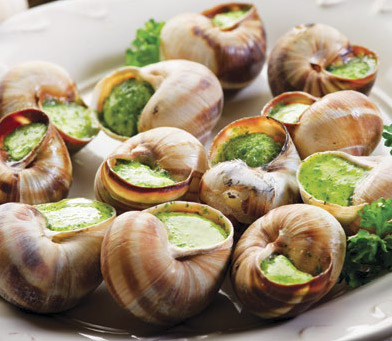 Previously French cuisine consisted of pottages, pies, stews and copious amounts of meat and spices. Then the royal chefs of France started a revolution. Costly foreign spices like saffron, ginger and cumin were replaced with local flavours like thyme, sage and tarragon, and mish-mashed dishes gave way to simple plates cooked to enhance the natural flavours of the ingredients.
Previously French cuisine consisted of pottages, pies, stews and copious amounts of meat and spices. Then the royal chefs of France started a revolution. Costly foreign spices like saffron, ginger and cumin were replaced with local flavours like thyme, sage and tarragon, and mish-mashed dishes gave way to simple plates cooked to enhance the natural flavours of the ingredients.

Pioneering French chefs of the 17th century started with two key elements still recognized as quintessentially Franconian today: wine & cheese. While any members of the population française are apt to throw in a hunk of bread, some fruit and call it a meal, the country’s cooks will simmer, roast, grill, broil, braise and brine to their hearts content.

The French keep it local with appellation d’origine contrôlée (AOC) certification, which determines whether a food or wine can legally be called “Roquefort” or “champagne” based on the town, city or region from which it came. Many famous French foods hail from Burgundy and are cooked in the eponymous variety of red wine, such as boeuf bourguignon, coq au vin and oeufs en meurette. Other staples, like dishes à la bordelaise (cooked with red wine from Bordeaux), à la lyonnaise (cooked with white wine from Lyon), and choucroute garnie (a white wine sauerkraut from Alsace) also include AOC-certified local wines.
But don’t worry about your students having to pass on the boeuf bourguignon—cooking boils away the alcohol.
French cheese also finds its way into a number of cooked favorites: croque monsieur, fondue and brie en croûte, to name a few, but it can be just as delicious on its own. Visit the Rue Mouffetard and stop into a fromagerie for samples on our guided neighborhood foodie tour. Chances are it will be the best cheese you’ve ever tasted…if you’re into stinky bleus and bries, of course. Roquefort, camembert and chèvre claim international fame, but the sheer variety available will put your knowledge of cheese, and your French, to the test. Enjoy samples in the market, then set off on your own to discover all the French delicacies for purchase, like escargot, frog legs, eel, sea urchin, even veal or lamb brains. Though not all your students may be up for the Parisian hoof-to-snout eating philosophy, we encourage everyone to try new things while practicing their French haggling for goods in the market.
On our Taste of France tour, along with our other tours to France, you’ll have numerous opportunities to taste everything from macarons at Ladurée to cassoulets in Carcassonne. But beyond baguettes and brie, the evolution of Franconian fare throughout the ages has encompassed everything from pork intestine potage to soufflés to couscous. Visit the Troglodyte Village on our French Highlights tour where people lived primitively not too long ago, and taste the mushrooms and snails foraged from the caves. Dine at a traditional North African restaurant to taste the savory grain-based dish of couscous, a staple of French cuisine for decades (perhaps centuries) and the country’s third favourite food. Top it all off with crêpes for dinner (or dessert!) and you’ve experienced the full spectrum of a cuisine centuries in the making. Bon appétit!
Some of our most popular France tours:
Interested in customizing your France tour with other destinations? Easy; filter the countries you want your students to explore on your next educational tour.

